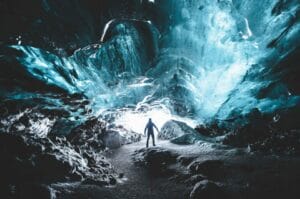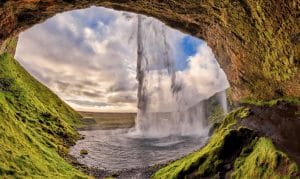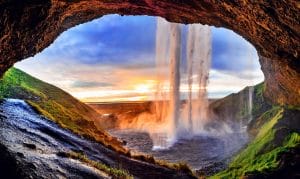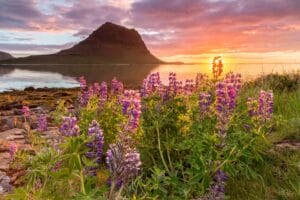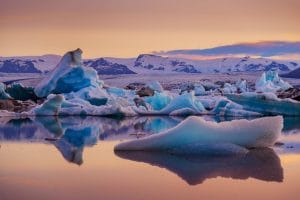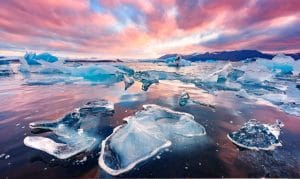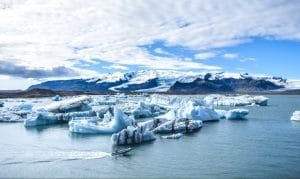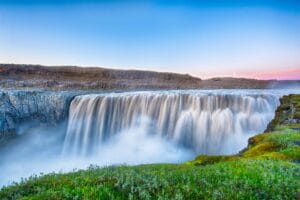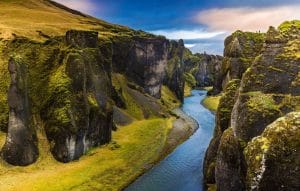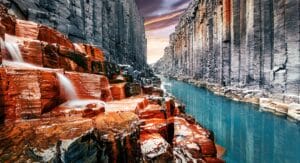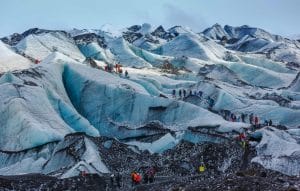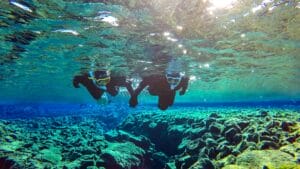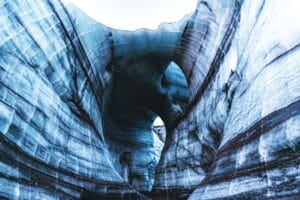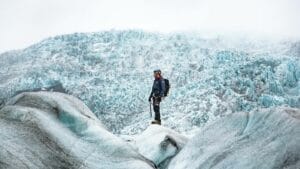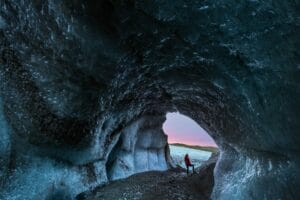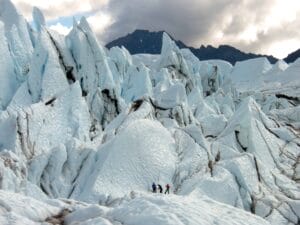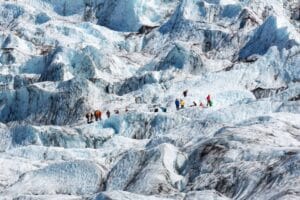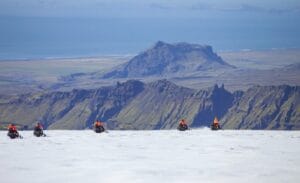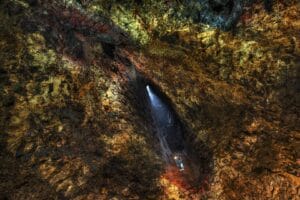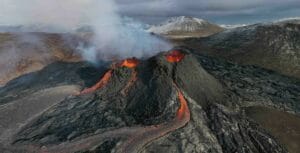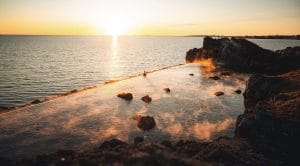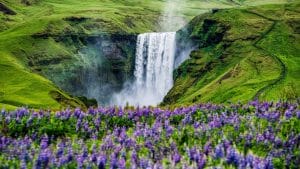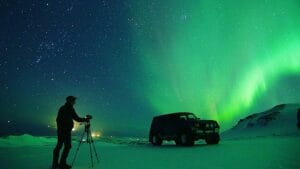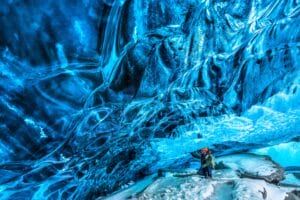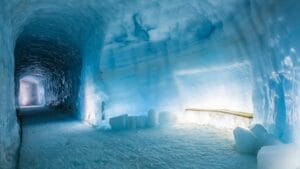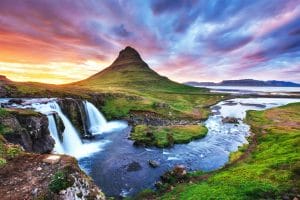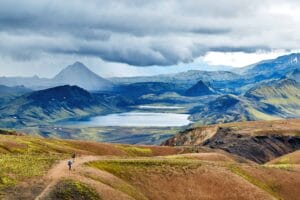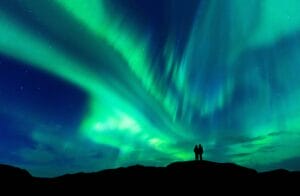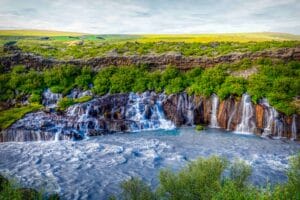February is an incredible time to visit Iceland, offering a mix of winter magic, cultural experiences, and fewer crowds compared to the peak summer months. With snow-covered landscapes, the chance to see the Northern Lights, and a variety of unique activities, Iceland in February is a dream destination for adventure seekers and nature lovers alike.
This guide will cover everything you need to know about visiting Iceland in February, including the weather, activities, events, and essential travel tips.
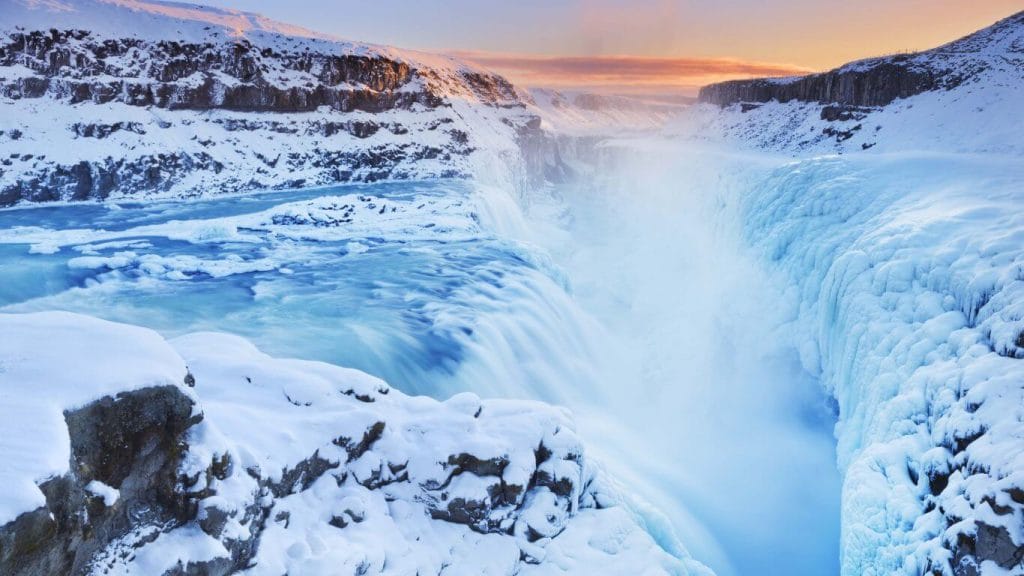
What to Expect in February
Weather in February
Iceland in February is deep into winter, which means cold temperatures, occasional snowstorms, and shorter daylight hours. Despite this, the weather can be surprisingly variable, with clear skies one moment and snow the next.
- Average Temperatures: -1°C to 4°C (30°F to 39°F)
- Daylight Hours: Around 7-10 hours, increasing as the month progresses. By late February, you can expect about 10 hours of daylight.
- Wind: Iceland is known for its strong winds, which can make the temperature feel much colder. Be prepared with windproof clothing.
Crowds and Pricing
February is part of Iceland’s low season, so you can expect fewer tourists and lower prices for accommodations and tours. However, popular activities like Northern Lights tours and glacier hikes still book up, so it’s a good idea to reserve in advance.

Things to Do in Iceland in February
February offers an incredible range of activities, from chasing the elusive Northern Lights to exploring breathtaking frozen landscapes. This time of year showcases Iceland’s winter beauty at its finest, with fewer crowds and plenty of opportunities for adventure. Below, we dive deeper into the must-do experiences that will make your February visit unforgettable.
1. Chase the Northern Lights
Seeing the Northern Lights is a bucket-list experience for many visitors to Iceland, and February is one of the best months to witness this natural wonder. The long, dark nights combined with clear winter skies provide optimal conditions for spotting the aurora borealis. These dazzling displays of light, caused by solar particles colliding with Earth’s atmosphere, are mesmerizing and unforgettable.
- Best Locations: Head to remote areas like Þingvellir National Park, the Snaefellsnes Peninsula, or the southern coast for the best views.
- Northern Lights Tours: Join a guided Northern Lights tour for expert tips on spotting the aurora and finding the clearest skies. This is the best way to guarantee the best possibility to see the Northern Lights.
Best Locations for Aurora Viewing:
- Þingvellir National Park: Just a short drive from Reykjavik, this UNESCO World Heritage site offers wide-open skies and minimal light pollution.
- Snæfellsnes Peninsula: Known as “Iceland in Miniature,” this area provides stunning backdrops for aurora photos, including the iconic Kirkjufell Mountain.
- South Coast: Remote beaches and waterfalls like Seljalandsfoss and Skógafoss become magical settings for Northern Lights viewing.
- North Iceland: Towns like Akureyri and Húsavík are quieter and offer excellent conditions for seeing the lights.
Tips for Northern Lights Hunting:
- Use a Tour Guide: Guided tours take you to the best spots with real-time updates on aurora activity and weather conditions. Many tours also provide photography tips and warm beverages.
- Check the Forecast: Use websites like vedur.is to monitor aurora activity (Kp index) and cloud cover.
- Stay Warm: Bundle up with multiple layers, as you may spend hours outside waiting for the lights to appear.
- Bring a Camera: Capture long-exposure photos of the lights with a tripod and a wide-angle lens. Learn how to photograph the northern lights here.
Some tours even combine Northern Lights hunting with unique experiences like hot spring dips or nighttime glacier hikes, making the adventure even more memorable.
2. Explore Ice Caves
Visiting an ice cave is one of the most awe-inspiring activities in Iceland, and February is prime ice cave season. These natural wonders, formed by meltwater carving through glaciers, create intricate ice tunnels and chambers that glow in vivid shades of blue. Exploring these caves is like stepping into another world.
Top Ice Caves to Visit:
- Crystal Ice Cave (Vatnajökull Glacier): This is the most famous and accessible ice cave in Iceland, known for its shimmering blue ice walls and expansive chambers.
- Katla Ice Cave: Located near Mýrdalsjökull Glacier, this cave combines ice and volcanic ash layers, creating striking black-and-blue patterns.
- Into the Glacier: Into the Glacier is a man made ice tunnels in Langjokull Glacier that is accessible all year. The experience is great and the guides are very knowledgeable about the glaciers in Iceland.
What to Expect on an Ice Cave Tour:
- Ice caves are only accessible with professional guides, so book a tour to ensure safety and access.
- Most ice cave tours include transportation to the cave, glacier gear (like helmets and crampons), and professional guides who ensure safety.
- The caves are constantly changing, so each visit is unique, with new formations and colors every season.
3. Glacier Hiking and Snowmobiling
Iceland’s glaciers dominate the landscape, and February is the perfect time to experience them up close through glacier hiking and snowmobiling. These activities combine adventure with breathtaking views, offering a truly immersive experience of Iceland’s icy wilderness.
Glacier Hiking:
- Popular spots include Sólheimajökull Glacier on the South Coast and Vatnajökull Glacier, Europe’s largest glacier.
- Glacier Hiking Tours provide all necessary gear, including crampons, ice axes, and helmets. Guides lead you through crevasses, ice sculptures, and frozen ridges, ensuring safety and providing fascinating insights into glacial geology.
Snowmobiling:
- For thrill-seekers, snowmobiling is an exhilarating way to traverse Iceland’s glaciers. Popular tours are available on Langjökull Glacier and Mýrdalsjökull Glacier.
- Snowmobile tours often include stops at scenic viewpoints where you can take in panoramic views of the surrounding mountains and ice fields.
Both activities are suitable for beginners, but they do require a moderate level of fitness. These glacier experiences are not only thrilling but also highlight the beauty and fragility of Iceland’s glaciers in the face of climate change.
4. Relax in Geothermal Hot Springs
After a day of exploring Iceland’s winter landscapes, there’s nothing more relaxing than soaking in a geothermal hot spring. February’s chilly weather makes this experience especially satisfying, as the contrast between the warm water and crisp air creates a uniquely Icelandic spa experience.
Must-Visit Hot Springs:
- Blue Lagoon: This iconic spa near Reykjavik offers milky blue waters enriched with silica and minerals. February’s cooler temperatures make it a perfect time to enjoy the steaming lagoon.
- Secret Lagoon: Located in Flúðir near the Golden Circle, this natural hot spring offers a quieter and more rustic alternative.
- Reykjadalur Hot Springs: For adventurous visitors, a hike through Reykjadalur Valley leads to naturally warm streams where you can bathe surrounded by mountains.
- Local Pools: Every Icelandic town has a public swimming pool with hot tubs, saunas, and geothermal pools. These are great for mingling with locals and experiencing authentic Icelandic culture.
Hot springs are not only relaxing but also a great way to rejuvenate after outdoor adventures, making them a highlight of any February itinerary.
5. Visit Frozen Waterfalls
Iceland’s waterfalls are spectacular year-round, but in February, many of them take on a magical quality as ice formations embellish their cascades. Snowy landscapes and frozen mist create picture-perfect scenes that are unique to winter.
Top Waterfalls to Visit:
- Gullfoss: This Golden Circle highlight transforms into a partially frozen wonder, with layers of ice framing its powerful cascades.
- Skógafoss: Known for its immense size and dramatic winter setting, this South Coast waterfall is a must-see in February.
- Seljalandsfoss: Although walking behind the waterfall may not be possible due to ice, its winter beauty is unmatched.
- Goðafoss: Located in North Iceland, this “Waterfall of the Gods” is stunningly framed by ice and snow.
Tips for Visiting Winter Waterfalls:
- Wear waterproof and insulated clothing to stay dry and warm near the spray.
- Bring crampons or ice cleats for safe walking on icy paths.
6. Drive the Golden Circle
The Golden Circle is one of Iceland’s most famous routes and remains accessible in February, offering a mix of natural wonders and historical sites. While it’s a popular summer destination, visiting in winter provides a more tranquil experience with snow-dusted landscapes.
Highlights of the Golden Circle:
- Þingvellir National Park: A UNESCO World Heritage site where you can see the rift between the North American and Eurasian tectonic plates.
- Geysir Geothermal Area: Watch the Strokkur geyser erupt every few minutes, sending steaming water into the air.
- Gullfoss Waterfall: Marvel at the frozen beauty of this iconic two-tiered waterfall.
Many Golden Circle tours in February include additional stops, such as geothermal bakeries or hot springs, adding extra warmth and charm to your day.
7. Explore Reykjavik in Winter
Reykjavik in February is full of cozy charm, cultural events, and vibrant winter energy. The city’s small size makes it easy to explore, even in colder weather.
What to See:
- Visit landmarks like Hallgrímskirkja Church and Harpa Concert Hall.
- Stroll along the harbor to see the Sun Voyager sculpture and enjoy views of Mount Esja.
Cultural Highlights:
- Reykjavik’s museums, like the National Museum of Iceland and the Settlement Exhibition, offer insight into the country’s history and culture.
- Enjoy live music, art galleries, and Icelandic design shops.
February is also a great time to savor Icelandic cuisine, with hearty dishes like lamb stew and fresh seafood warming you up after a day in the cold. We recommend the Reykjavik Walking Tour and the Reykjavik Food Tour to maximize your experience.

February Events in Iceland
Winter Lights Festival
- Location: Reykjavik
- When: Early February
- What to Expect:
- Reykjavik’s Winter Lights Festival is a city-wide celebration marking the end of the darkest days of winter. The event features art installations, light shows, and cultural performances throughout the city.
- Landmarks like Harpa Concert Hall and Hallgrímskirkja Church are illuminated with colorful light displays.
- Popular activities include nighttime museum visits, outdoor yoga under the lights, and walking tours of light art installations.
Bolludagur, Sprengidagur, and Öskudagur
These three traditional days mark the lead-up to Lent in Iceland and are celebrated with delicious food and fun activities:
- Bolludagur (Bun Day): Enjoy cream-filled buns covered in chocolate.
- Sprengidagur (Bursting Day): Indulge in salted meat and peas.
- Öskudagur (Ash Wednesday): Kids dress up in costumes and sing for candy, similar to Halloween.
5. Dark Music Days
- Location: Reykjavik
- When: Late January to Early February
- What to Expect:
- Dark Music Days is an annual festival dedicated to contemporary and experimental music, held at Harpa Concert Hall.
- It features performances by Icelandic and international artists, with a focus on innovative and avant-garde compositions.
- This event is perfect for music enthusiasts looking for something different and cutting-edge.
6. Reykjavik International Games
- Location: Reykjavik
- When: Late January to Early February
- What to Expect:
- This multi-sport event showcases Icelandic and international athletes competing in a variety of sports, from swimming and gymnastics to fencing and weightlifting.
- Visitors can attend events and cheer on competitors in the lively atmosphere.
7. Annual Thorri Festival
- Location: Nationwide
- When: Late January to Mid-February (Thorri Month in the old Icelandic calendar)
- What to Expect:
- The Thorri Festival is a time to honor old Icelandic traditions, particularly through food. Visitors can sample a Thorri platter, which includes traditional Icelandic dishes like fermented shark (hákarl), sour ram testicles, blood pudding, and dried fish.
- While not for everyone, this festival is a fascinating glimpse into Iceland’s Viking heritage.
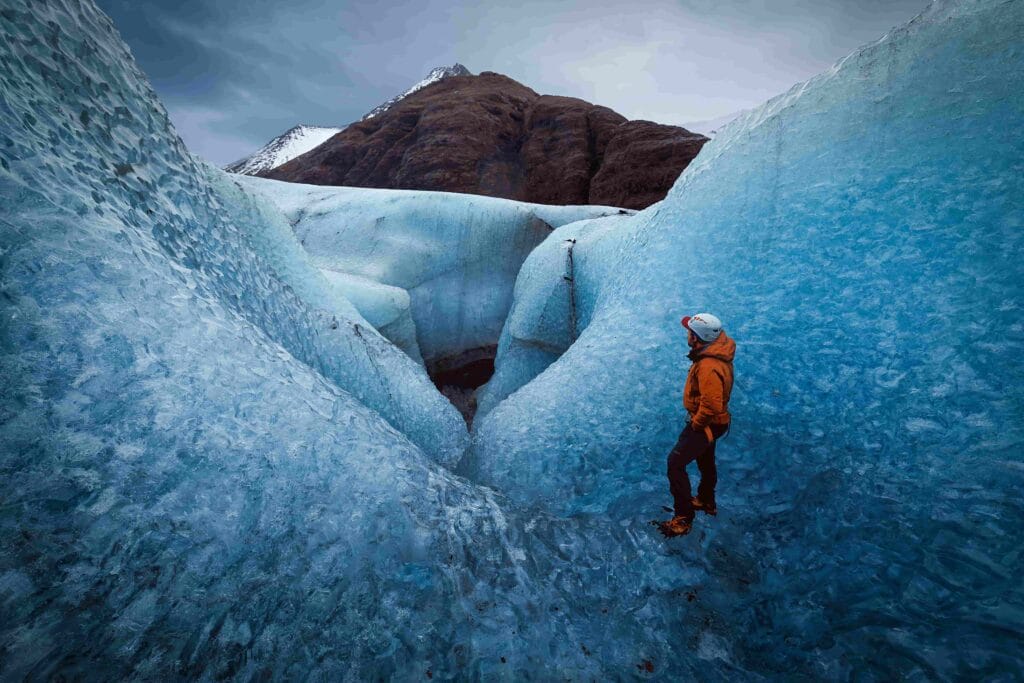
Tips for Visiting Iceland in February
Dress for the Weather:
- Layer up with thermals, waterproof outerwear, and warm accessories like hats and gloves.
- Wear sturdy, insulated boots with ice cleats for icy conditions.
Plan for Shorter Daylight:
- Make the most of daylight hours by planning activities in advance.
- Use the early evenings for Northern Lights hunting or relaxing in hot springs.
- If you need help planning your trip in February, we recommend having locals that know the daylights help you. Reach out to one of our local experts here.
Book Key Activities in Advance:
- Popular tours like ice caving and glacier hiking fill up quickly, so reserve early to secure your spot.
Prepare for Changing Conditions:
- Icelandic weather can change rapidly. Be flexible with your itinerary and allow extra time for travel.
Why Visit Iceland in February?
February offers a unique blend of winter beauty, thrilling activities, and cultural experiences. The landscapes are stunningly draped in snow and ice, and the chance to see the Northern Lights adds a magical touch. With fewer tourists and off-season pricing, February is an ideal time for travelers seeking an authentic and adventurous Icelandic experience.
Whether you’re hiking on glaciers, soaking in hot springs, or marveling at the aurora borealis, a February trip to Iceland promises unforgettable memories and breathtaking sights. Embrace the winter wonderland and let Iceland’s raw beauty captivate you!
What to pack for your trip to Iceland in February
Packing appropriately for a February trip to Iceland is essential to ensure you stay warm, dry, and comfortable while exploring the country’s winter landscapes. Here’s a comprehensive list of must-have items for your adventure:
1. Clothing
Layering is key for managing Iceland’s unpredictable weather. Aim for three main layers: a base layer, insulating mid-layer, and waterproof outer layer.
1. Base Layer (Moisture-Wicking)
- Thermal underwear (tops and bottoms made of wool or synthetic materials).
- Moisture-wicking socks (preferably wool for warmth).
2. Mid-Layer (Insulating)
- Fleece jackets or sweaters.
- Insulated pants (fleece-lined or thermal leggings).
- Wool or down sweater for extra warmth.
3. Outer Layer (Waterproof and Windproof)
- Waterproof winter jacket (Gore-Tex or similar materials work best).
- Waterproof pants or ski pants to protect from snow and rain.
4. Accessories
- Insulated gloves or mittens (waterproof preferred).
- Wool or fleece hat that covers the ears.
- Buff or scarf to protect your neck and face from wind.
- Thermal socks (bring multiple pairs).
2. Footwear
1. Waterproof Boots
- Insulated hiking boots with good grip for icy surfaces.
- Waterproof winter boots for less rugged activities.
2. Ice Cleats or Crampons
- Essential for walking on icy paths near waterfalls or in cities.
3. Comfortable Shoes
- For indoor use or casual strolls in Reykjavik.
3. Outdoor Gear
1. Daypack
- A small backpack for day trips to carry essentials like water, snacks, and extra clothing.
2. Swimsuit and Towel
- For visiting hot springs, like the Blue Lagoon or natural geothermal pools.
3. Reusable Water Bottle
- Iceland’s tap water is some of the cleanest in the world.
4. Headlamp or Flashlight
- Helpful for exploring during darker hours, especially for Northern Lights tours.
5. Sunglasses
- Snow glare can be strong during sunny winter days.
6. Thermos
- Great for keeping tea or coffee warm during outdoor adventures.
4. Electronics
1. Camera and Accessories
- DSLR or mirrorless camera for capturing the Northern Lights and landscapes.
- Tripod (essential for long-exposure shots of the aurora borealis).
- Extra memory cards and batteries (cold weather drains batteries quickly).
2. Power Bank
- For charging devices during long excursions.
3. Travel Adapter
- Iceland uses European-style plugs (Type C or F, 220V).
4. Smartphone
- For navigation, photography, and weather updates.
With this packing list, you’ll be ready to embrace Iceland’s winter wonders and make the most of your February adventure!

We hope this article about Iceland in February will help you figure out if it’s the best month for you to visit Iceland or not.
We would love to hear your thoughts. Tell us about your tips and tricks to when it comes to planning a trip to Iceland.
It would be perfect if you let us know about your favorite locations from your trip. It’s even better if they are hidden gems that you would like to share with the rest of us.
Leave your comments and questions below and we will happily answer all of them.

